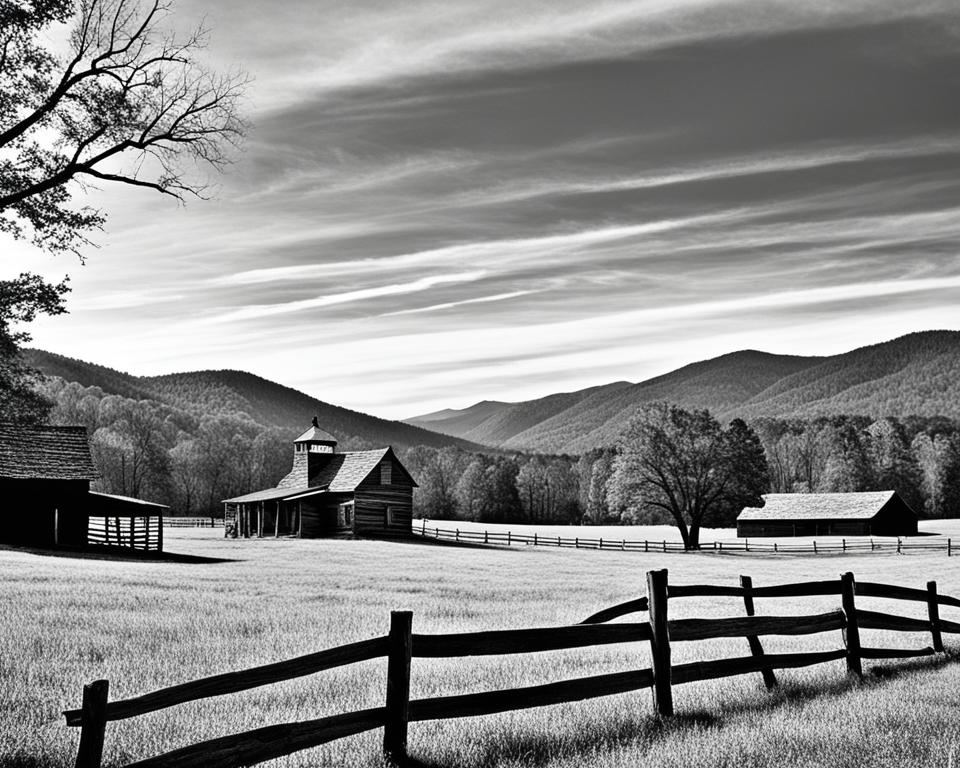
Cades Cove History: From Cherokee Homeland to Pioneer Settlement
Discover the captivating history of Cades Cove, a picturesque valley nestled in the heart of the Smoky Mountains. This enchanting region holds the tales of the Cherokee Indians, who once roamed its pristine landscapes, and the brave pioneers who carved out a new life in this unspoiled wilderness. Join us on a journey through time as we delve into the intriguing past of Cades Cove and explore its transformation from a Cherokee homeland to a thriving pioneer settlement.
Located in Great Smoky Mountains National Park, Cades Cove has witnessed centuries of historical significance. Originally used as a seasonal hunting camp by the Cherokee, this land became a part of Tennessee history with the signing of the Treaty of Calhoun in 1819. With this pivotal moment, Cades Cove passed into the hands of European settlers, who began to establish a community and shape its destiny.
The first permanent European settlers in Cades Cove were John and Lucretia Oliver, who arrived in 1818. Their arrival marked the beginning of a new era in the valley, attracting other pioneers seeking a fresh start in the untamed wilderness. Over time, the community flourished, and Cades Cove became a bustling hub of activity.
However, the Civil War brought division and hardship to this once-unified community. Residents found themselves torn between loyalties, with some supporting the Union and others siding with the Confederacy. This internal strife led to raids by Confederate bushwhackers, exacerbating the tensions that plagued the cove during this turbulent period.
Despite the challenges, Cades Cove persevered and adapted to the changing times. In the post-war era, the community experienced a decline in population and faced economic struggles. However, the residents embraced new opportunities, transitioning from farming to logging in the early 1900s. Additionally, the production of moonshine emerged as a means of survival and sustenance.
Today, Cades Cove stands as a testament to the resilience of its people and the preservation of its history. Great Smoky Mountains National Park ensures that the cultural heritage and landmarks of the cove are protected for future generations to explore and appreciate. Visitors can wander among the historic structures, including cabins, barns, and churches, gaining insight into the pioneering spirit that once thrived in this captivating landscape.
Join us on this remarkable journey through Cades Cove’s enthralling history, and discover the enchanting blend of Cherokee legacy and pioneer determination that defines this extraordinary corner of the Smoky Mountains.
The Role of Native Americans in Cades Cove History
The Cherokee Indians played a significant role in the early history of Cades Cove. The area served as a seasonal hunting camp for the Cherokee, who hunted in the cove and created trails through it. However, they never permanently lived inside the cove. The only remnant of Cherokee life found in Cades Cove is a “seasonal hunting camp.” The Cherokees eventually relinquished their claim to the land with the signing of the Treaty of Calhoun in 1819.
The Arrival of European Settlers and the Early Pioneers of Cades Cove
The early 19th century marked the arrival of European settlers in Cades Cove, an area with a rich history in the Great Smoky Mountains. Among the first permanent European settlers were John and Lucretia Oliver, who made Cades Cove their home in 1818. They were joined by William “Fighting Billy” Tipton, who received a land grant in 1821. The Tipton brothers went on to own much of the valuable agricultural land in the valley.
The European settlers faced numerous challenges in the untamed wilderness of Cades Cove. They cleared the land, cultivated crops, and built essential structures for survival. By 1850, the population of Cades Cove had grown to 671 people, reflecting the vitality and resourcefulness of the early pioneers.
Through their tenacity and hard work, the early pioneers laid the foundation for the thriving community that Cades Cove would become. Their stories of resilience and determination continue to shape the history and heritage of this remarkable place.
The Impact of the Civil War on Cades Cove
The Civil War had a significant impact on the tight-knit community of Cades Cove, nestled in the picturesque Great Smoky Mountains. The conflict between the Union and the Confederacy fueled division among the residents, leading to a tense environment that forever transformed the cove.
Before the war, Cades Cove served as a stop on the Underground Railroad, with many residents harboring a pro-Union sentiment. However, there were also Confederate supporters within the community, setting the stage for a divided population.
“We were neighbors, friends, and kin, but the war had us at odds,” shares local historian Sarah Evans. “It was heartbreaking to see our community torn apart by clashing loyalties.”
The division birthed a dangerous situation, with Confederate bushwhackers launching raids on Cades Cove. These marauders targeted Union supporters, causing loss of life and theft of essential provisions. The bushwhackers’ ruthless actions left an indelible mark on the community.
One such story of survival is that of Elijah Oliver, son of John Oliver, one of the early pioneer settlers. Elijah, a staunch Union supporter, had to take refuge in the mountains, hiding from the Confederate bushwhackers until the war’s end.
The impact of the Civil War on Cades Cove was profound, causing many residents to abandon their homes and seek safer territories. The population dwindled, leaving behind a community scarred by the division and violence.
Preserving the Tales of Resilience
Today, as visitors explore Cades Cove in the Great Smoky Mountains National Park, they are reminded of the community’s challenging past. The endurance and resilience of the residents during the Civil War era are immortalized through the preservation of historic landmarks and oral histories.
The Cades Cove Museum serves as a gateway to the past, offering a glimpse into the lives of those who experienced the trials of the times. Structures like the Primitive Baptist Church, where the local community gathered in defiance of the U.S. government’s presence, stand as testaments to the spiritual and cultural fabric of the cove.
As time moves forward, it is essential to remember the impact of the Civil War on Cades Cove, a community forever changed by the division, violence, and resilience of its people.
Post-War Challenges and Changes in Cades Cove
After the Civil War, Cades Cove faced numerous challenges and underwent significant changes that shaped its future. One of the key issues was the population decline that occurred in the aftermath of the war. The conflict had taken a toll on the community, leading many residents to seek refuge elsewhere.
The economic struggles faced by Cades Cove were another consequence of the war. The agricultural-based economy that had sustained the community for years was in decline. In response, the people of Cades Cove transitioned from farming to logging in the early 1900s, seeking new economic opportunities to support their livelihoods.
“The transition from farming to logging brought a much-needed boost to the local economy.”
Alongside the economic changes, an illicit activity emerged in Cades Cove in the post-war years: the production of moonshine. The production of corn liquor, also known as moonshine, became prevalent in the community, sometimes operating illicitly and illegally. This underground economy provided a source of income for some residents during a time of economic uncertainty.

The changes and challenges faced by Cades Cove did not deter the community from persevering. Against all odds, Cades Cove thrived for over a hundred years, adapting to the evolving circumstances with resilience and determination.
“Cades Cove exemplified the resilient spirit of its inhabitants, who found creative solutions to navigate the changing times.”
However, in the late 1920s, the United States government decided to create the Great Smoky Mountains National Park, and Cades Cove was included within its boundaries. This decision ultimately led to the displacement of the last resident in 1937, as the land was preserved for future generations to appreciate and enjoy.
The Preservation of Cades Cove History and Landmarks
The rich history and cultural heritage of Cades Cove are meticulously preserved within the boundaries of the Great Smoky Mountains National Park. Exploring the area, visitors have the opportunity to witness the enduring legacy of Cades Cove through its historical landmarks and structures. Step back in time as you stroll through the well-preserved cabins, barns, and churches that once served as the heart of this thriving pioneer settlement.
One of the notable landmarks in Cades Cove is the Primitive Baptist Church, which played a vital role in the religious and social fabric of the community. In defiance of the U.S government, this church continued to hold services until 1960, showcasing the unwavering faith of its members. Today, it stands as a testament to the resilience and determination of the early settlers in this picturesque valley.
To further delve into the captivating history and culture of Cades Cove, visitors can visit the Cades Cove museum. This educational institution offers a deeper understanding of the challenges and triumphs experienced by the people who called this area home. Take the opportunity to immerse yourself in the stories and artifacts that paint a vivid picture of life in Cades Cove throughout the ages.
The preservation of Cades Cove’s history and landmarks within the Great Smoky Mountains National Park is an ode to its significance in Appalachian history and its enduring value as a living testament to the past. As you explore this remarkable destination, let the echoes of the past guide your footsteps, igniting your imagination as you discover the untold stories of the brave pioneers who shaped this extraordinary corner of the Smoky Mountains.